The Firmament, Third Heaven, and Structure of Things Biblical
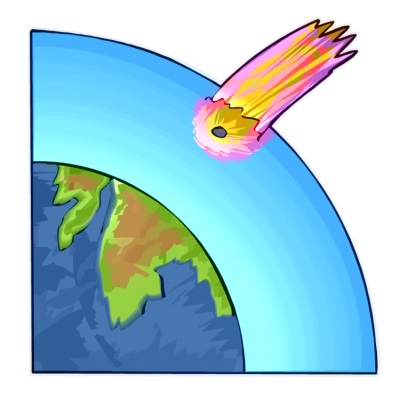
On the second day in the Genesis narrative the Lord calls for there to be a "firmament" in the "midst of the waters" to divide the waters:
"And God said, Let there be a firmament in the midst of the waters, and let it divide the waters from the waters. And God made the firmament, and divided the waters which were under the firmament from the waters which were above the firmament: and it was so. And God called the firmament Heaven. And the evening and the morning were the second day."
(Genesis 1:6-8 KJV)
The term "firmament" and its identity has been one of the greatest puzzles concerning the Creation account, mostly because of its Hebrew definition:
רָקִיעַ raqiya` raw-kee'-ah
from 7554; properly, an expanse, i.e. the firmament or (apparently) visible arch of the sky:—firmament.
רָקַע raqa` raw-kah'
a primitive root; to pound the earth (as a sign of passion); by analogy to expand (by hammering); by implication, to overlay (with thin sheets of metal):—beat, make broad, spread abroad (forth, over, out, into plates), stamp, stretch.
Most people interpret this to mean just the expanse of the sky (the atmosphere) or outer space, or both (which it is), but the full meaning goes well beyond that simplistic interpretation. The creation of the firmament is associated with the placement of a defined heavenly structure. Many modern scholars consign the term "firmament" as a relic of a pre-scientific culture and translate the Hebrew word raqia as a "dome" or "vault" in some modern Bibles, but it is rendered as "firmament" in the KJV for good reason. The problem that puzzles people is the implication in the Hebrew language of the firmament being a firm, fixed structure (FIRMament). That structure, and the KJV word choice, can be explained in the context of the Ruin-Reconstruction interpretation of Genesis.
The Creation Scientists of today's Fundamentalism (Young Earth Creationists) have interpreted the "waters above the firmament" as a theoretical "water canopy" which once surrounded the Earth, but no longer exists. They cite this as their source for the waters of Noah's flood. This is absolutely incorrect and a concept that does not exactly hold water (pun intended) when closely examined within the literal framework of the Bible's Genesis narrative. The reason is because of what is said in this passage:
"And God said, Let there be lights in the firmament of the heaven to divide the day from the night; and let them be for signs, and for seasons, and for days, and years: And let them be for lights in the firmament of the heaven to give light upon the earth: and it was so. And God made two great lights; the greater light to rule the day, and the lesser light to rule the night: he made the stars also."
(Genesis 1:14-16 KJV)
This verse says that the Sun, Moon, and Stars are "in" the firmament. Therefore, applying the rules of grammar and logic, those waters that are "above the firmament" must therefore be above the Sun, Moon and Stars. In other words, those particular waters are ABOVE the visible cosmos. For some this is a hard pill to swallow, but that is exactly what the Bible is saying.
"Praise him, ye heavens of heavens, and ye waters that [be] above the heavens."
(Psalms 148:4 KJV)
The Bible says that all wisdom and knowledge is found in the Lord Jesus Christ, the incarnate Word of God (See Colossians 2:3). The same holds true for the Holy Scriptures, the written Word of God. According to the Scriptures, there is a physical/spiritual structure to the universe. The Apostle Paul makes reference to the importance of this knowledge in the book of Ephesians where he wrote:
"That Christ may dwell in your hearts by faith; that ye, being rooted and grounded in love, May be able to comprehend with all saints what [is] the breadth, and length, and depth, and height; And to know the love of Christ, which passeth knowledge, that ye might be filled with all the fulness of God."
(Ephesians 3:17-19 KJV)
Pay close attention to the structure of the grammar. Paul is speaking about two different things in this passage. The first is the structure of things, "the breadth, and length, and depth, and height;" then there is the conjunction word "And" which is followed by the second thing, "to know the love of Christ, which passeth knowledge." In other words, Paul is saying there are two things the believer can and should know. 1) The dimensions and structure of all things physical things and how they are structured, 2) The love of Christ, a spiritual thing which is beyond full comprehension by man. A corollary to the truth of this passage is found in this Old Testament proverb:
"The heaven for height, and the earth for depth, and the heart of kings [is] unsearchable."
(Proverbs 25:3 KJV)
The firmament deals with the structure of the present heavens and Earth (Genesis 2:1), as opposed to the structure of the original heaven and Earth (Genesis 1:1). In the present heavens and Earth there exists a three (3) heavens structure. In the old world of the original creation, there was a different configuration. Let's look at Genesis 1:6 again and more closely:
"And God said, Let there be a firmament in the midst of the waters, and let it divide the waters from the waters. And God made the firmament, and divided the waters which [were] under the firmament from the waters which [were] above the firmament: and it was so."
(Gen 1:6-7 KJV)
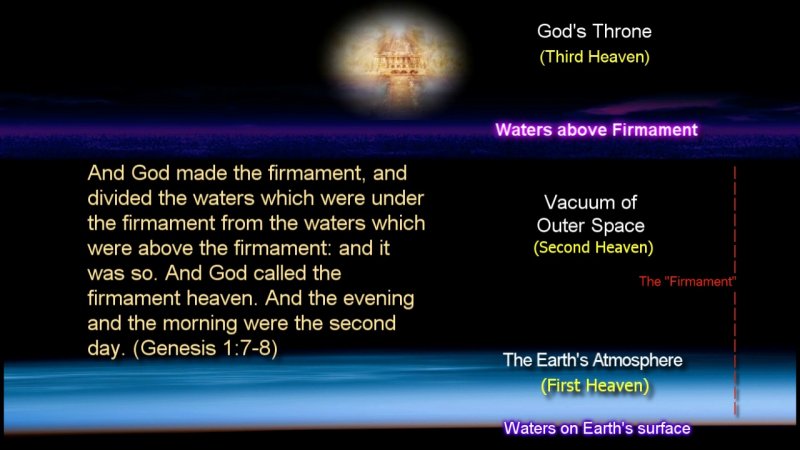
On the second day of the regeneration, the Lord God "divided" the waters (plural) of the great "deep" into two (2) parts, with a "firmament" in the midst. According to Genesis 1:10, both the waters that were upon the face of the Earth and the waters which He placed above the firmament He called "Seas":
"And God called the dry [land] Earth; and the gathering together of the waters called he Seas: and God saw that [it was] good."
(Gen 1:10 KJV)
We know that the waters on the Earth are called "Seas" in the Bible, but there is also another "Sea" that is spoken of in the Scriptures and that one is above the firmament. (Special note: Notice that the word "Sea" is capitalized at Genesis 1:10 in the KJV Bible). But, exactly where is "ABOVE" the firmament? During the seven-days of the Genesis regeneration the Lord God defined Three (3) heavens. The first heaven is the Earth's atmosphere:
"And God said, Let the waters bring forth abundantly the moving creature that hath life, and fowl [that] may fly above the earth in the open firmament of heaven."
(Gen 1:20 KJV)
The second heaven is the vast expanse of the physical universe - outer space as we call it:
"And God said, Let there be lights in the firmament of the heaven to divide the day from the night; and let them be for signs, and for seasons, and for days, and years:"
(Gen 1:14 KJV)
These two heavens constitute a continuum called the "firmament," and this firmament is collectively called "Heaven":
"And God called the firmament Heaven. And the evening and the morning were the second day."
(Gen 1:8 KJV)
The Third Heaven is above this upper "Sea," and this higher sea is below the Throne of God:
"And before the throne there was a sea of glass like unto crystal: and in the midst of the throne, and round about the throne, were four beasts full of eyes before and behind."
(Revelation 4:6 KJV)
This particular "Sea" is above the firmament (the known physical universe). It represents a firm and impassable barrier between the world of man (below) and the world of God (above).
"Then said the Jews, Will he kill himself? because he saith, Whither I go, ye cannot come. And he said unto them, Ye are from beneath; I am from above: ye are of this world; I am not of this world."
(John 8:22-23 KJV)
Here are some additional proof verses in the Bible which refer to this particular Sea:
"Praise him, ye heavens of heavens, and ye waters that [be] above the heavens."
(Psalms 148:4 KJV)
This is the "sea" that John saw in his visions:
"And before the throne [there was] a sea of glass like unto crystal: and in the midst of the throne, and round about the throne, [were] four beasts full of eyes before and behind."
(Rev 4:6 KJV)
As we said, this is a present "sea" of separation is a FIRM and impassable barrier between the world of man (below) and the world of God (above) and they only way through there is in the Lord Jesus Christ. That barrier structure can be seen in the design of the Tabernacle and the Temple. It is represented by the Veil.
The diagram below shows a comparison of these things to the structure and layout of Moses' Tabernacle, which is the same basic arrangement used in the layouts of the First and Second Jewish Temples in Jerusalem.
The "Sea" under discussion is a barrier between the second and third heavens, represented by the veil between the 'Holy Place' and 'Holiest of All.'
The 'Brazen Alter' represents the Earth where the sacrifice was to be made. In Christian theology, the Brazen alter represents the Cross of Christ where the 'Lamb of God' was sacrificed. You MUST be washed in the Blood of the Lamb of God.
The 'Laver' in Moses' Tabernacle, and the 'Molten Sea' in Solomon's Temple (see below), were places for the priests to wash themselves before entering the 'Holy Place'. In the Christian doctrine of salvation by God's Grace, this represents where you are Sanctified, washed by the water of the Word of God (Ephesians 5:26-27).
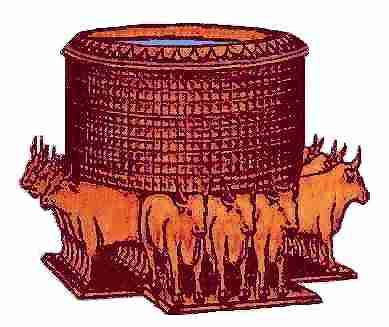
The Third Heaven
This now gives us a better understanding of what the Apostle Paul was talking about in the book of 2 Corinthians 12:2, where he speaks of a place called the "third heaven":
"I knew a man in Christ above fourteen years ago, (whether in the body, I cannot tell; or whether out of the body, I cannot tell: God knoweth;) such an one caught up to the third heaven."
(2 Cor. 12:2 KJV)
Although the "third heaven" is not directly mentioned in the Genesis narrative, the established structure of all things is defined in Genesis 1 and, when understood, allows us to comprehend exactly where and what Paul was talking about when he mentions the "third heaven" in his letter. It also gives the reader a better understanding of John's vision in Revelation 4. Again, when the Lord God divided the waters He created a boundary which presently exists between the two lower heavens (which constitute the firmament) and the third heaven (where the throne of God is). That boundary is that "Sea," and again that "sea" is above the two lower heavens of the firmament. It is also likened in places to crystal or smooth glass:
"And the likeness of the firmament upon the heads of the living creature was as the colour of the terrible crystal, stretched forth over their heads above."
(Ezekiel 1:22 KJV)
The reason it appears like a smooth, crystal surface is because it is frozen:
"The waters are hid as [with] a stone, and the face of the deep is frozen."
(Job 38:30 KJV)"And they saw the God of Israel: and there was under his feet as it were a paved work of a sapphire stone, and as it were the body of heaven in his clearness."
(Exodus 24:10 KJV)
It is also likened to glass:
"And I saw as it were a sea of glass mingled with fire: and them that had gotten the victory over the beast, and over his image, and over his mark, and over the number of his name, stand on the sea of glass, having the harps of God."
(Revelation 15:2 KJV)
With this understanding of what exactly the Firmament is and the structure of all things that God made during the seven days, many things that were previously obscure suddenly take on real meaning and enrich the reader's understanding.
In summary, here is the structure of the physical world as it now exists from the face of the Earth upwards:
- The lower sea of physical waters (our seas and oceans)
- The first heaven (the atmosphere)
- The second heaven (outer space)
- The sea above outer space and below the third heaven (a sea of separation)
- And above it all, there is the Third Heaven.
"That Christ may dwell in your hearts by faith; that ye, being rooted and grounded in love, May be able to comprehend with all saints what [is] the breadth, and length, and depth, and height; And to know the love of Christ, which passeth knowledge, that ye might be filled with all the fulness of God."
(Ephesians 3:17-19 KJV)
The structure of the heavens is a recurring theme throughout the Bible. It is reinforced (in typology) throughout the Bible. For example, it is likened to the floors of a building, which we call "stories" and, sure enough, the same word is even used in the KJV Bible. It is used to describe the design of the heavens:
"[It is] he that buildeth his stories in the heaven, and hath founded his troop in the earth; he that calleth for the waters of the sea, and poureth them out upon the face of the earth: The LORD [is] his name."
(Amos 9:6 KJV)
This pattern of three (3) "stories" is also found in some other important things in the Bible, an example being the description of the design of Noah's Ark:
"A window shalt thou make to the ark, and in a cubit shalt thou finish it above; and the door of the ark shalt thou set in the side thereof; [with] lower, second, and third [stories] shalt thou make it."
(Genesis 6:16 KJV)
It is also used to describe the construction of the Temple:
"The door posts, and the narrow windows, and the galleries round about on their three stories, over against the door, cieled with wood round about, and from the ground up to the windows, and the windows [were] covered;"
(Ezekiel 41:16 KJV)
In the construction of Moses' Tabernacle in the wilderness there were three (3) main parts: 1) The outer court, where the brazen altar of sacrifice was. 2) The Holy Place, where the candlestick, table of shewbread, and golden altar of incense were. 3) The Holy of Holies where the Ark of the Covenant was. Again, note that between parts two and three was a curtain for a partition, which matches the "sea" above the firmament (in type) in the structure of the Three Heavens. It is no coincidence that all these Biblical things have a similar three-tiered structure. There is much spiritual insight to be gained in further study of those things:
- Three Heavens
- Three levels inside Noah's Ark
- Three floors in a section of the Temple
- Three sections to Moses' Tabernacle
Concerning the design of the Temple, keep in mind that Moses' tent Tabernacle and Solomon's Temple both had three (3) main parts:
- The outer court
- The holy place (where the table, lamp and incense alter was, outside the veil)
- The Most Holy Place (where the Ark was, behind the veil)
As you can see, this theme of structure based on threes is consistent throughout the Bible. Even the basic structure of the Earth has three (3) main divisions: the core, the mantle, and the crust.
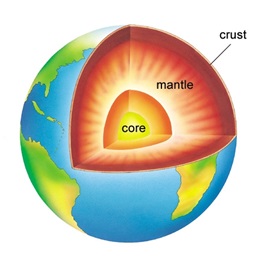
Does the Universe really have a structure? When you go into outer space is there really any such thing as up and down, is there a top and bottom? Does the cosmos have a definite shape? We cannot observe such in our three-dimensional view of the universe, but is that all that is really out there? Not according to the Bible! In the words of Lord Himself there is a world above the one we live in and can observe:
"And he said unto them, Ye are from beneath; I am from above: ye are of this world; I am not of this world."
(John 8:23 KJV)
The King James Authorized Version of the Holy Bible has its own internal set of words and definitions which are self-interpreting in their specific meaning and context. From Genesis to Revelation, translated from Hebrew, Aramaic, and Greek manuscripts, the KJV Bible's English translation is an integrated whole throughout the sixty-six books.
The English words "world" and "earth" are different words and have distinct, separate conceptual meanings in the Holy Bible and the English language. These meanings are defined by the Scriptures when used in context. Understanding this distinction is CRUCIAL to rightly-dividing the word of truth.
In the book of Hebrews, the Lord Jesus Christ is said to be the maker of the "worlds" (plural):
"Hath in these last days spoken unto us by [his] Son, whom he hath appointed heir of all things, by whom also he made the worlds;"
(Heb. 1:2 KJV)"Through faith we understand that the worlds were framed by the word of God, so that things which are seen were not made of things which do appear."
(Heb. 11:3 KJV)
The Greek word in these two verses for "worlds" is αιων (as in eon), which means an age or a perpetuity of specific prevailing conditions in time upon the face of the Earth. Therefore, the word "world," as doctrinally defined in our Bible, is NOT referring to other planets in outer space but to defined ages and prevailing conditions during those ages on the Earth, be they past, present, or future.
The "Earth" is a planet. It is a spherical-shaped mass of matter in time and space. The "world" is the specific set of conditions prevailing upon the face of the planet Earth at a specific point in Biblical time. The Earth is a part of our present world, past worlds, and the future world to come (see Matt 12:32, Mark 10:30, Hebrews 2:5), but the Earth itself is not the whole "world." Our present "world" also consists of the stars in the sky, the trees of the field, the people, the cities of the nations and the present evil world system on the face of the Earth:
"And it shall come to pass after the end of seventy years, that the LORD will visit Tyre, and she shall turn to her hire, and shall commit fornication with all the kingdoms of the world upon the face of the earth."
(Isaiah 23:17 KJV)"Who gave himself for our sins, that he might deliver us from this present evil world, according to the will of God and our Father:"
(Gal 1:4 KJV)
We'll use the example of the last "world" that will be on the face of the present Earth as an example. It is the future one-thousand-year reign of the Lord Jesus Christ in Jerusalem. It begins after He returns to Earth following the events of the Great Tribulation. That world is spoken of in the book of Revelation chapter 20. At the end of that "world" following the Great White Throne Judgment and the destruction of Death and the Devil, God will create a completely new and eternal heaven and Earth.
"And I saw a new heaven {single tense} and a new earth: for the first heaven and the first earth were passed away; and there was no more sea."
(Revelation 21:1 KJV)
The future world of the one-thousand-year reign of the Lord Jesus Christ will be on the current Earth. But because the face of the Earth will be so decimated by the wrath of God during the Great Tribulation period, the Lord will regenerate the heavens and Earth to restore it for Himself, His Bride, the Jewish people, and those of the nations of the Gentiles found worthy to enter.
"And Jesus said unto them, Verily I say unto you, That ye which have followed me, in the regeneration when the Son of man shall sit in the throne of his glory, ye also shall sit upon twelve thrones, judging the twelve tribes of Israel."
(Matthew 19:28 KJV)
The prophet Isaiah speaks of this regeneration:
"For, behold, I create new heavens {plural tense} and a new earth: and the former shall not be remembered, nor come into mind. But be ye glad and rejoice for ever in that which I create: for, behold, I create Jerusalem a rejoicing, and her people a joy. And I will rejoice in Jerusalem, and joy in my people: and the voice of weeping shall be no more heard in her, nor the voice of crying. There shall be no more thence an infant of days, nor an old man that hath not filled his days: for the child shall die an hundred years old; but the sinner being an hundred years old shall be accursed. And they shall build houses, and inhabit them; and they shall plant vineyards, and eat the fruit of them. They shall not build, and another inhabit; they shall not plant, and another eat: for as the days of a tree are the days of my people, and mine elect shall long enjoy the work of their hands. They shall not labour in vain, nor bring forth for trouble; for they are the seed of the blessed of the LORD, and their offspring with them. And it shall come to pass, that before they call, I will answer; and while they are yet speaking, I will hear. The wolf and the lamb shall feed together, and the lion shall eat straw like the bullock: and dust shall be the serpent's meat. They shall not hurt nor destroy in all my holy mountain, saith the LORD."
(Isaiah 65:17-25 KJV)
Take note of the phrase ‘"the child shall die" which tells us there is still death on the Earth when the Lord Jesus Christ begins His reign for those one-thousand-years.
"The last enemy that shall be destroyed is death."
(1 Corinthians 15:26 KJV)
And death is not finally destroyed until the end of that one-thousand years:
"And the sea gave up the dead which were in it; and death and hell delivered up the dead which were in them: and they were judged every man according to their works. And death and hell were cast into the lake of fire. This is the second death."
(Revelation 20:13-14 KJV)
Also take note of the phrase "for as the days of a tree are the days of my people" in Isaiah's prophecy. Trees can live to be a few hundred years old. This passage tells us that people born during the one-thousand-year reign of Christ will have extended lifetimes, because environmental conditions on the Earth at that time will be restored to similar as they were on the Earth before Noah’s flood. The phrase "the lion shall eat straw like the bullock" indicates that the animal kingdom will once again revert to vegetarian diets, also just like before Noah’s flood. And the serpent’s diet will remain the same as it was proscribed in Genesis 3:14.
"And the LORD God said unto the serpent, Because thou hast done this, thou art cursed above all cattle, and above every beast of the field; upon thy belly shalt thou go, and dust shalt thou eat all the days of thy life:"
(Genesis 3:14 KJV)
The formation of this new heavens and Earth is also spoken of by the prophet Jeremiah:
"I beheld the earth, and, lo, it was without form, and void; and the heavens, and they had no light."
(Jeremiah 4:23 KJV)
Although the words "without form, and void" are the same words as that are spoken in Genesis 1:2 at the start of the seven-days of Genesis, the prophet is speaking of a future regerative event. We know this because of what else is said in the following verses:
"I beheld the mountains, and, lo, they trembled, and all the hills moved lightly. I beheld, and, lo, there was no man, and all the birds of the heavens were fled. I beheld, and, lo, the fruitful place was a wilderness, and all the cities thereof were broken down at the presence of the LORD, and by his fierce anger. For thus hath the LORD said, The whole land shall be desolate; yet will I not make a full end. For this shall the earth mourn, and the heavens above be black: because I have spoken it, I have purposed it, and will not repent, neither will I turn back from it. The whole city shall flee for the noise of the horsemen and bowmen; they shall go into thickets, and climb up upon the rocks: every city shall be forsaken, and not a man dwell therein."
(Jeremiah 4:24-29 KJV)
In light of Jeremiah's words "without form and void" which denote a regeneration of the heavens and Earth, the Biblical interpretive 'Rule of First Mention' would suggest the same is true concerning the seven-days of Genesis and the formation of Adam's world.
Adam's world was pristine on the surface. But under Adam's feet, entombed and hidden in the rocks of the planet, was the buried fossil record - God's material testimony to the truth of the existence of a previous "world" on the face of the Earth and a long reign of death across ancient ages past, long before the new world of Adam. This material evidence, there all along but only scientifically examined and understood by man over the past two to three centuries, now speaks to us today about the existence of that previously-created world (Genesis 1:1), which came under subjection to death, was eventually destroyed (Genesis 1:2), and then Divinely replaced by the present world (Genesis 1:3-2:1).
For review purposes: The ancient world was under the stewardship of an "anointed" being, a spiritual creature called the covering cherub and named Lucifer. (See Isaiah 14:12-16 KJV and Ezekiel 28:13-17 KJV) Through Lucifer's sin of rebellion against God, the old world under Lucifer's stewardship was first subjected to Death and, through time, eventually perished. At the end of its time, when the stars of the old universe, including Earth's sun, perished, their remaining hydrogen gases oxidized into waters as darkness (both physical and spiritual) took its final toll upon the ancient Creation. That time is specifically what these two verses point to:
"And the earth was without form, and void; and darkness was upon the face of the deep. And the Spirit of God moved upon the face of the waters."
(Genesis 1:2 KJV)"For this they willingly are ignorant of, that by the word of God the heavens were of old, and the earth standing out of the water and in the water: Whereby the world that then was, being overflowed with water, perished: But the heavens and the earth, which are now, by the same word are kept in store, reserved unto fire against the day of judgment and perdition of ungodly men."
(2 Pet 3:5-7 KJV)
The old world was the first "generation" of the heaven and the Earth (Genesis 1:1). The heavens and Earth "which are now" are the second generation of the heavens and the Earth. It is the same planet Earth but different worlds upon the face of the same planet. This is why the Bible says:
"These are the generations of the heavens and of the earth when they were created, in the day that the LORD God made the earth and the heavens,"
(Genesis 2:4 KJV)
In the New Testament, this second generation of the heavens and the Earth is specifically referred to as "The Foundation of the World" and it is likened to a "conception" in the Scriptures. This will be discussed in the next chapter.
The Bible says that the waters of Noah's flood covered all of the Earth to above the peaks of the tallest mountains:
"And the waters prevailed exceedingly upon the earth; and all the high hills, that were under the whole heaven, were covered. Fifteen cubits upward did the waters prevail; and the mountains were covered."
(Genesis 7:19-20 KJV)
If this flood was literal and global, then we are confronted with the "Mount Everest" problem. Located in Nepal, Mount Everest is the Earth's highest peak. It is also the highest peak in a range of mountains stretching across 1,500 miles and containing more than 1000 peaks higher than 20,000 feet.
Mount Everest is presently at a height of 29,028 feet above sea level and getting taller at the rate of about 3-5 millimeters per year. Assuming the tectonic uplift rate of the Himalayan range has been uniform since the days of Noah's flood, Mount Everest would have been only about forty-three (43) feet shorter (28,985 ft.) back in Noah's day. That is still a considerable height, equal to about 5.5 miles above present sea level. It would take a lot of water for the flood to reach that depth - more water than is presently above the crust of the earth. Where did so much water come from and where did it go after the flood?
Before answering that question, let's put this puzzle into perspective. Our Earth is about 25,000 miles in circumference. If it was compared to the size of a basketball, the Earth's crust would be about as thick as a sheet of tissue paper wrapped around it. In a global perspective, 5.5 miles of water above today's sea level is a relatively minute quantity, increasing overall circumference by only 0.044%. Of course, to people on the order of five to six feet in stature, 5.5 miles is a lot. The thing to keep in mind is perspective.
Many Young Earth Creationists (Creation Scientists) espouse the theory that most of the Earth's mountains and sedimentary rock strata were formed underwater during Noah's flood by massive global volcanic and tectonic activity. They then conclude that because the mountains formed during the flood, not as much water was needed to cover the Earth to "fifteen cubits" above the highest mountain as Genesis 7:20 requires. Nice try, but no prize.
That answer does not meet the Scriptural or geophysical requirements, as the Bible clearly says that the mountains were already there, and by implication, the continents and tectonic plates were in their present-day locations, give or take a hundred yards to account for 4,000+ years of continental drift. Additionally, the alleged underwater volcanic and tectonic activity, on such a massive scale as proposed by Creation Science models, would have produced a great deal of acid which would be detectable as SO4 ions in the Greenland Ice Sheet core record. That evidence is simply not there. This is covered in more detail in another chapter. (See, Global Dust Spikes, Greenland Ice Sheet, Paleoclimate Indicators and Collapse of Civilizations All Correlate to Date of Noah's Flood)
Instead of taking the usual approach - that Noah's Flood could not have happened because of this fact or that fact - let's approach the problem from this angle: Noah's Flood did happen because the Bible is true, so let's try and find answers that can fit the facts, both scientific and Biblical. After all, Jesus Himself confirmed that the flood was a real event (see: Mt 24:37-38; Lu 3:36; Lu 17:26-27), so there must be an explanation. First, let us closely examine the exact wording of the Bible to begin determining the correct answers to this mystery.
"And God said unto Noah, The end of all flesh is come before me; for the earth is filled with violence through them; and, behold, I will destroy them with the earth."
(Genesis 6:13 KJV)
Notice that the Lord says the agency of destruction would be the Earth itself. The planet Earth has three spheres: the core, mantle, crust (lithosphere), the seas (hydrosphere), and the air in the heaven above (atmosphere). All three of these played a part in the destruction of the antediluvian world, so the complete answer is not necessarily confined to just geology but it is confined to the Earth.
"In the six hundredth year of Noah's life, in the second month, the seventeenth day of the month, the same day were all the fountains of the great deep broken up, and the windows of heaven were opened. And the rain was upon the earth forty days and forty nights."
(Gen 7:11-12 KJV)"The fountains also of the deep and the windows of heaven were stopped, and the rain from heaven was restrained;"
(Gen 8:2 KJV)
According to the above Scriptures, there were two related sources for the waters of Noah's flood. There were "fountains" of water coming up out of the Earth and there was water coming down from the "windows" of heaven. The fountains began first and triggered a complex chain reaction that brought the rain. These fountains came from below the Earth's crust then affected things far into the upper atmosphere.
There are two types of water fountains that occur in nature. One is called an Artesian well/spring. Artesian wells occur when a hole penetrates into the earth to a region where internal pressure causes the water to flow upward like a fountain.
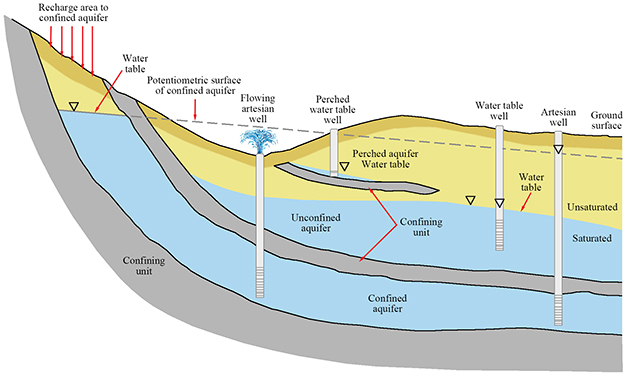
The internal pressure that drives such fountains is produced when the head of the particular water table penetrated is at a higher elevation than the spring opening. The principle is similar to the gravity pressure that drives water out of your sink tap because the city water supply is stored in an elevated tower above the town.
The second type of fountain is called a geyser. Geysers occur when waters in underground chambers are heated by the surrounding host rock until the pressure and temperature cause them to flash to steam and erupt upwards. When the chamber is emptied, replacement water flows back into the chamber, the replacement water is heated, and the cycle repeats. An excellent example of this is seen in Yellowstone National Park's "Old Faithful" geyser.
According to what is written in the Scriptures, the fountains of Noah's flood may have been a similar form of geyser activity on a massive, world-wide scale, concentrated along the mid-oceanic ridge system and driven by water-saturated magma accumulated below the oceanic crust. A careful reading of Genesis 7:6-10 indicates that the flood waters were already rising for about seven days before the fountains "were broken up" and broke forth in full output.
"And Noah was six hundred years old when the flood of waters was upon the earth. And Noah went in, and his sons, and his wife, and his sons' wives with him, into the ark, because of the waters of the flood. Of clean beasts, and of beasts that are not clean, and of fowls, and of every thing that creepeth upon the earth, There went in two and two unto Noah into the ark, the male and the female, as God had commanded Noah. And it came to pass after seven days, that the waters of the flood were upon the earth. In the six hundredth year of Noah's life, in the second month, the seventeenth day of the month, the same day were all the fountains of the great deep broken up, and the windows of heaven were opened. And the rain was upon the earth forty days and forty nights."
(Genesis 7:6-12 KJV)
Careful parsing of the above passage indicates that great amounts of water were already being added to the Earth's seas at least seven days before the rains even began. This means that sea level was already rapidly rising, flooding low lying coastal areas and sending panicked low-land inhabitants inland from the rising seas. Meanwhile, presumably up on much higher ground, Noah and his family took shelter in the massive gopher wood vessel which remained firmly nested in its construction frame, unmovable and secure until the rising waters lifted it from its resting place.
The great volume of water this early in the flood event could only come from massive undersea "fountains" beginning to breech the crust all along the mid-oceanic ridge system. But this preliminary out-flow was still insufficient to breech the ocean's surface. The volume of underwater displacement would, however, be sufficient enough to generate global tsunami (tidal waves) activity, quickly drowning inhabitants who lived near the seas.
Seven days into the flood the undersea fountains broke through the crust in full fury, and the pressure of the flow sent scalding columns of superheated water upwards, breeching the ocean's surface and erupting skyward as a globe-encircling curtain of steam rocketing into the upper atmosphere. As the steam came into contact with the colder air it would condense and produce cloud cover and relentless rainfall on a planetary scale. This is precisely the sequence of events described in this part of the passage:
"In the six hundredth year of Noah's life, in the second month, the seventeenth day of the month, the same day were all the fountains of the great deep broken up, and the windows of heaven were opened. And the rain was upon the earth forty days and forty nights."
(Gen 7:11-12 KJV)
NOTE: Hydrothermal fluid temperatures coming out of present-day vents on the ocean floor can reach 400°C (750°F) or more, but they do not boil under the extreme pressure of the deep ocean. See: Hydrothermal Vents
This first passage, at the beginning of the flood, says that the rains did not begin until AFTER the fountains of the great deep are broken up.
"The fountains also of the deep and the windows of heaven were stopped, and the rain from heaven was restrained;"
(Gen 8:2 KJV)
The second passage says the rains ceased only AFTER the fountains stopped. This is fully consistent with a geyser-type model.
As briefly mentioned earlier, the most likely geological location for the "fountains" (geysers) was along a narrow, globe encircling series of underwater Tectonic Plate boundaries called the mid-oceanic ridge, where the Earth's oceanic crust is currently spreading apart at the rate of a few centimeters per year. This continuous system of faults is seen on a map of the Earth's sea floors as running south down the middle of the Greenland Sea and the North and South Atlantic Oceans. It then extends eastward into the Indian Ocean basin, onward between Australia and Antarctica and into the great Pacific Ocean basin. It then continues northward along the eastern side of the Pacific basin.

Scientists are studying what they term as a large "open wound" where the Earth's oceanic crust is missing deep under the Atlantic Ocean near that ridge system. What scientists are keen to know is whether the crust was ripped away by huge geological faults, or whether it never even developed in the first place. Could this be an actual location where the fountains of the great deep were "broken up" as the Bible indicates? Read the story: Serpentinite not crust, scientists to find out how part of Earth's crust went missing.
The geysers' source would have been extensive underground reservoirs of magma supersaturated with water that had collected in the regions below the boundary of the oceanic crust and above the underlying mantle region. The next graphic is a simplified schematic cross-section of the Atlantic Ocean basin, with the mid-oceanic ridge at the center.

Here is an important question to note: Why would magma, supersaturated with water, only accumulate under the crust of the oceans and not under the continents? There are two reasons. First, water, being much lighter than rock, would have gravitated upwards until it was blocked by the crust. It would then tend to pool between the Crust-Mantle boundaries. Secondly, because the Earth's crust is much thinner under the ocean floors (5 - 12 km) than under the continents (35 km average), it would naturally pool where the Earth's crust was thinnest - under the basaltic oceanic basins which ride higher on the mantle.
The underground region where this water-saturated magma would have collected is above a zone called the Asthenosphere, commonly known as the Mohorovic discontinuity. The behavior of seismic waves passing through that region appears to show relative liquidity as compared to the rock in the regions above and below it. See also: "Keeping Earth's Plates Oiled" and "Lab study suggests small layer of water, CO2 and silicate lies beneath tectonic plates."

Graphic from https://www.geog.ouc.bc.ca/physgeog/contents/images/lithosphere.jpg
Scientists have found evidence to confirm the presence of large volumes of water deep inside the Earth, enough to fill Earth's ocean basins 10 times over (see also Earth Mantle 'Ocean': 3-D Seismic Model Of Vast Water Reservoir Revealed). Only a fraction of such an amount would be required to raise sea levels to meet the requirements of Noah's flood. By the way, long before scientists learned there were vast amounts of water under the Earth, the Bible already hinted at this fact (see Exodus 20:4).
If a large volume of water-saturated magma had pooled under the Earth's ocean basins, it is probable that the oceans were much shallower back then as compared to the Post-Flood times of today. Earth's sedimentary geology is replete with evidence of shallow-water sea depositions. And that same geology reveals fluctuations in global sea levels across geologic time that greatly exceed what could possibly be caused by accumulations and melting at the polar caps. One of the possible explanations put forth to explain this mystery is "sea floor warping" and periodic accumulations and releases of waters from supersaturated magma, as proposed in this model, and that could account for this observation. In addition, it would be more likely that a rupture in the crust would occur, and these waters released, if the accumulation of magma below the oceanic crust was placing great upward pressure against the crust.
Therefore, we will assume that at the time just before Noah's flood the seas were more shallow than today. If this was indeed the case, then explaining how much of the flood waters rapidly receded becomes simple to explain. Basic law of Physics: For every action there is an equal and opposite reaction. After the great volume of waters which were formerly trapped below the Earth's oceanic crust jetted upwards, condensed, and fell into the regions above the oceanic crust, they quickly began to produce an accumulative great reverse-pressure on the thin crust of the ocean floor.

In the meantime, because of the sudden release of the great pressure in the supersaturated magma below the crust, there would have been a relative cooling effect on the remaining magma body. This cooling, along with the loss of the volatiles (the waters), would reduce the volume of the underlying magma chamber, causing it to shrink. This would facilitate the crust being pushed downward by the weight of the surface waters above and thus forming the vast Abyssal plains we see today on both sides of the mid-ocean spreading ridge.

This downward warping of the ocean floors and the mid-oceanic ridge system can be clearly seen in the Global Relief Map below:
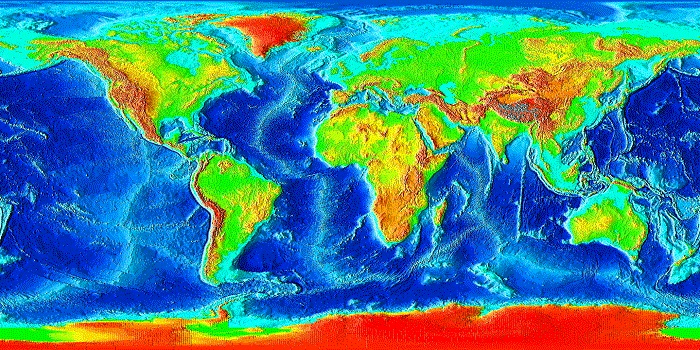
Based on sea mount and Continental Shelf evidence (discussed in detail in the chapter concerning the Days of Peleg), sea level after Noah's flood abated to a level about 1,000 meters higher today than it was before the flood.
And that is the basic proposed geologic component of the Flood Model. Below is a short video that may help you better visualize the "Fountains" model of the great flood.
In the next chapter you will learn about the complex chain reaction this triggered in the Earth's atmosphere and the resultant changes that sharply decreased the life-span of man on this side of the flood.
Before proceeding to other aspects of the flood event, we need to address an objection to this geologic model posed by accepted plate tectonic theory: If sea floor spreading and volcanic activity along the mid-oceanic ridge has been ongoing for millions of years, what explains this anomalous eruption of waters at this particular point in the Earth's history? This is a fair question, for which I only have a Biblical answer.
The reader will note that in the days of Adam the vegetation of the Earth was watered by a mist that came up out of the ground:
"And every plant of the field before it was in the earth, and every herb of the field before it grew: for the LORD God had not caused it to rain upon the earth, and there was not a man to till the ground. But there went up a mist from the earth, and watered the whole face of the ground."
(Genesis 2:5-6 KJV)
This "mist" seems to indicate that there was a great deal of heated water present under the Earth and relatively close to the surface, or at least making its way to the surface at various places in order to produce this mist. A Divine reconfiguration of the Earth's geology, during the process of the seven days of Genesis when God made the "foundation of the world" (See the chapter entitled "Creation or Catabolism?"), is the only possible explanation. Surely the Lord knew that He had created an unstable situation that would eventually cause the flood centuries later in the days of Noah. Granted, this is not a scientific answer, but one that is theologically sound given our understanding of God's omnipotence and foreknowledge.
The bottom line is that the geologic conditions that produced the massive geysers of Noah's days, however they came about, no longer exist. Therefore, there can be no repeat of this activity on such a great scale (See Genesis 9:15 for confirmation). In other words, the very mechanics and conditions that produced the great flood event self-destructed upon completion of the flood event cycle, thus the geologic changes became permanent. So, unlike the "Old Faithful" geyser, this was a one-time event.
Before we discuss the atmospheric chain reaction that was triggered by the "Fountains of the Deep", and the complexity of the "Windows of Heaven" component of the flood model (Genesis 7:11-12), we need to consider one of the most notable post-flood effects. Specifically, that according to the Bible, the life-spans of mankind dropped almost exponentially following the flood. Obviously, something in the Earth's post-flood environment was very different than before Noah's flood, because before the flood some men lived to be just short of 1,000 years old. Below is a Life Span graph showing the ages of 23 men of the Bible from Adam to Joseph.
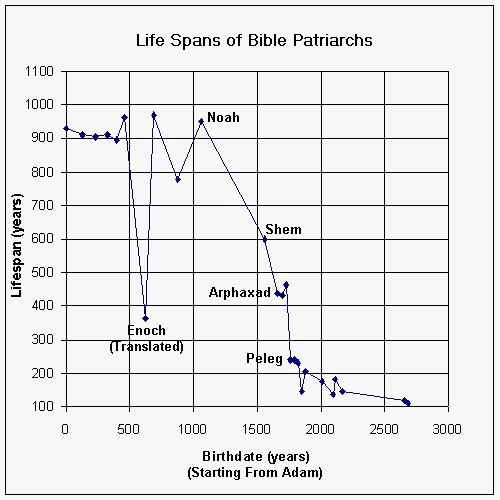
The life spans drop sharply immediately following and during the 101 year interval between the flood event and the significant post-flood event in the days of Peleg. It then slowly levels out to a less steep decline in the days of the Patriarchs of Israel.
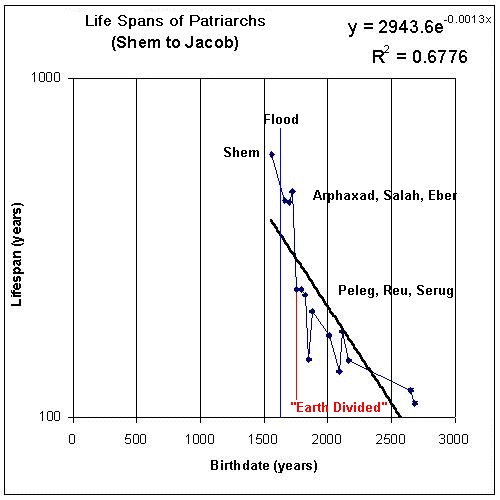
"And unto Eber were born two sons: the name of one was Peleg; for in his days was the earth divided; and his brother's name was Joktan."
(Genesis 10:25 KJV)"And unto Eber were born two sons: the name of the one was Peleg; because in his days the earth was divided: and his brother's name was Joktan."
(1 Chronicles 1:19 KJV)
We will discuss the specifics of the days of Peleg in the next chapter.
Many theories have been proposed to scientifically explain the long-life phenomenon of pre-flood man. Possible explanations for the decrease in human life spans after the flood range from an increase in the amount of radiation reaching the Earth's surface to changes in the atmosphere's pressure or composition, or a combination of factors.
An analysis of the graphs reveal that Noah, who was born 600 years before the flood, lived only 350 years after the flood but had a total life span of 950 years, which was only 19 years less than Methuselah. His son Shem, who was born only 98 years before the flood, lived 500 years after the flood but had a total life span of only 598 years, or about 2/3 the life span of his father. This data suggests that the level of physical body maturity at the time of the flood may hold the key to understanding the long life spans of antediluvian mankind. In other words, children remained children for much longer, reached puberty much later, and their bodies stayed much healthier through a greatly extended adulthood before the flood.
Support for this assumption comes from the Bible chronology and the notations of when pre-flood men fathered their first offspring. Observe in the record of the Generations of Adam (Genesis chapter 5) and note the ages of listed men and how old they were when they begat their first children: Seth 105 years, Enos 90 years, Cainan 70 years, Mahalaleel 65 years, Jared 162 years, Enoch 65 years, etc. See that pattern? It tends to indicate that men did not become sexually mature until at least 60 or 70 years of age. And those who had their first children many years past that maturity point (i.e. Jared 162, Methuselah 187, Lamech 182, and Noah 500) probably restrained from procreation for social or religious reasons. The bottom line is that pre-flood men of the age of 50 to 60 years were physiologically equivalent to today's teenagers.
In researching the cause of these greatly expanded pre-flood age-spans, my first inclination was that this must be somehow connected with the functioning of the human pituitary gland. But what was different after the flood that could cause the aging process to accelerate? I considered increased amounts of solar and cosmic radiation in the post-flood world as a possibility, but the existence of C14 in organics dating from the times of Adam and even before him ruled out cosmic radiation. I considered the possibility that perhaps the atmosphere of the Earth back in those days may have filtered out some other form of solar radiation. This could have been part of the answer but did not seem to be enough by itself.
Then, while reading an article about Hyperbaric oxygen (HBO) therapy for treating injuries, a possible answer came in a bolt of inspiration: Could it be that the reason men lived longer in pre-flood days was because the Earth's atmospheric pressure was considerably higher back then and that man was originally made to thrive in a higher-pressure, higher oxygen concentrated atmospheric environment?
In Hyperbaric therapy, a person is placed in a pressurized chamber and the air pressure is increased 1 to 2 times that of normal sea level atmospheric pressure (14.7 psi). Under the increased air pressure more oxygen gets into the bloodstream. This process seems to accelerate healing of wounds, promotes tissue repair, and even favorably affects metabolic rates and the performance of the hormonal systems. In fact, in researching the subject, there appears to be a wide range of medical benefits from living in a pressurized environment. It almost seems to be something that should be natural. So why isn't the world like that today if such conditions are so naturally beneficial? Perhaps before the flood, it was the natural order of things.

If that was indeed the case, then men and women age quicker and start dying sooner these days because we are living in conditions that are not optimal for our original biological design. If the antediluvian world had a much higher atmospheric pressure, then a large volume of Earth's atmospheric gas has since vanished. How and why? We can assume that the ratio of the various gases in the atmosphere back then was similar to today (i.e. nitrogen 78.1%, oxygen 20.9%, argon 0.9%, carbon dioxide 0.035%, water vapor, and other gases), otherwise the difference in chemical composition would show up in the polar Ice Core measurements. And the temperature dependent ratio of oxygen18 to oxygen16 isotopes would not have been affected by differences in air pressure, to the best of my knowledge. I am unaware of any paleo proxy measurement that could verify the possibility of increased atmospheric pressure on the earth at that time, as compared to today.
Some of our Young Earth Creationist brethren have also reached the conclusion that the antediluvian world had a much higher atmospheric pressure. They also cite the benefits of hyperbaric oxygen as a possible contribution to the longevity of pre-flood mankind. Good for them (every once in a while they get one right), but then they attribute the increased pressure to presence of their mythical "water canopy" that they say God placed above the Earth's atmosphere when He divided the waters (Genesis 1:6) and was the liquid water source for the "windows of heaven" component of the flood. They are wrong on both of those latter assumptions.
What is needed is an antediluvian atmospheric model that, unlike the YEC's "water canopy" assumption, does not violate the laws of physics and can explain how the Earth's atmosphere became reduced in volume.
Since we have no idea what the actual atmospheric pressure could have been back then, let us assume a figure of about 1.5 to 2 atmospheres (14.7 psi X 2 = 29.4 psi). That would be a range in which the hyperbaric benefits would be close to optimum without the effects of nitrogen narcosis or oxygen toxicity (about equal to scuba diving in 25-30 feet of water).
We next need to determine the total weight of the additional atmospheric gas, and in doing the math we find that the present weight of the atmosphere is 4.99 X 1014 tons. Double that and you have the total weight of an additional atmosphere. Of course about 75% of the additional gas would accumulate close to the ground within the lowest 12 -15 kilometers, so the total height of the upper atmosphere's edge would still be close to what it is at present. Although that total tonnage is quite mind-boggling, it only represents about two millionths of the Earth's total mass; the Earth's gravitational pull would be slightly increased, but not by very much.
One possible additional benefit of a thicker atmosphere would be a reduction in the amount of harmful radiation reaching the Earth's surface. Solar radiation is not a simple, single entity. It actually comprises many forms such as electromagnetic radiation, X-rays, gamma rays, and high-speed particles like electrons, protons, neutrons, and atomic nuclei. This factor, combined with the HBO effect, could have been the difference that allowed antediluvian mankind to reach the great ages declared in the Bible. The full verdict is still out on this matter.
We need to address two other issues: 1) How did Noah's family in the Ark and the marine life in the seas escape being fried by the tremendous volume of heat released by the global geyser activity, and 2) How was the atmosphere reduced to present pressure levels? Let us answer the second question first.
When the "fountains" (a belt of geysers along the global oceanic ridge system) began on the Earth, creating the world-wide cloud cover and heavy rains, beginning seven days into the flood sequence, the heat energy from those geysers would have naturally traveled upward as a column. Upon encountering the colder air in the upper atmosphere, the steam would condense and rain would be precipitated. We're talking about rapidly soaring thermal air currents on a massive scale that would also drag heated atmospheric heavy gasses (oxygen - nitrogen, etc.) upwards into the higher elevations, as well. As all this heat accumulated in the upper regions, the sphere of the Earth's atmosphere would expand, pushing outwards and further away from Earth's gravity-well. If through this heating the atmosphere distended enough, portions of it would be ripped from the Earth's gravitational field by the sun's solar winds. Those gases would be lost into space. Consequently, after the flood and after the heat source abated, the upper atmosphere would began to cool and shrink back to more normal size. But with great volumes of atmospheric gasses lost through this process, remaining air pressure at sea level would be reduced to present-day levels.
As for how Noah's family and Earth's marine life survived, they were protected by the dense cloud cover and the heavy rains. For a couple of reasons, the critics are incorrect in arguing that the heat from the geysers would fry everything on the surface of the Earth. First, heated air rises and most of the heat from the geysers would be dissipated high above the Earth's surface. Second, radiant heat (infra-red) from the ascending mix would not travel far horizontally because of the heavy precipitation falling below the cloud cover. That cloud cover would act as a shield from the heat accumulating in the regions above the cloud cover. The rainfall would have been warm, but not overly so.
And at this juncture another important point should be made. All the waters falling from the heavens would have been FRESH WATER. Because salt water is denser than fresh water, a large fresh water "lens" would have formed on top of the saline ocean basins and especially over submerged continental areas. This fact can go a long way in accounting for the survival of fresh-water fish and some forms of vegetation. The Bible says that at least one olive tree survived in the earth and sprouted fresh leaves after the flood waters subsided (see Genesis 8:11). If olive trees could survive those conditions, certainly the old Bristlecone pine trees could as well.
That completes this proposed flood model. Is this a farfetched model? You be the judge. It is only an hypothesis, but meets the requirements of the literal wording of the Bible and does so through the agency of observable scientific principles.
Question: Noah's Ark came to rest on a peak of the "mountains of Ararat." This is a mountain range situated between the Black and Caspian Seas in southern Armenia. The Bible does not say that the Ark came to rest atop Mount Ararat in Turkey. More likely, as indicated by the travel direction of the people who migrated into the place called Babel (see: Genesis 11:2), the Ark came to rest on a mountain top farther to the east near the present-day northern Iraq/Iran region. That fact could also explain the flood legend in the fabled Epic of Gilgamesh that predates the writing of the books of Moses. But how did humans and animals quickly migrate to the other continents like Australia and North America, which are presently separated by the seas?
To begin to answer this important question we must examine another lesser-known, but important event that occurred on the Earth about one hundred years after Noah's flood:
"And unto Eber were born two sons: the name of one [was] Peleg; for in his days was the earth divided; and his brother's name [was] Joktan."
(Genesis 10:25 KJV)"And unto Eber were born two sons: the name of the one [was] Peleg; because in his days the earth was divided: and his brother's name [was] Joktan."
(1 Chronicles 1:19 KJV)
In the Hebrew language the name "Peleg" means a dividing by a "small channel of water" and is also root associated with the meaning of an earthquake. The Hebrew word translated as "divided" in the passage means to "split" something. According to the Bible genealogy, this man named Peleg was born 101 years after the flood. No doubt this Peleg was so named because of an event of great significance to the people living at the time he was born. The fact that this dividing event is mentioned by the Holy Spirit in TWO places in the Scriptures, and that the EXACT number of years between this event and the flood is also recorded, alludes to the importance of these passages in the interpretation of post-flood history.
Some Creationists have interpreted this event to be the division of the North and South American continents from the European and African continents by the Atlantic Ocean after the flood. But a division of such magnitude at that point in geologic time would invalidate our previously proposed flood model. It would also invalidate accepted paleomagnetic data which supports gradual sea floor spreading at the mid-Atlantic ridge. Besides, the Atlantic Ocean is no "small channel of water" between land masses. Obviously, that is not the answer we are looking for.
After examining the Hebrew meanings, a more plausible alternative interpretation would be that it describes an earth-splitting event such as a valley opening in the ground and filling with water. That could have happened anywhere along the Dead Sea Rift zone (discussed in detail later) and may have been associated with a delayed adjustment of the Earth's plates in response to the rapid subsidence of the sea floors by the flood.
In theory, when the weight of the waters of the flood forced the sea floors downward to fill the void left in the magma chambers beneath, strain would have developed between the oceanic and continental portions of the crustal plates. Consequently, tectonic pressures were redistributed. About 100 years later the strain and pressure redistribution may have caused the Earth's crust to rapidly rent in weaker places, much like a piece of ridged plastic which can be stretched and deformed. It will eventually snap if the strain remains constant. An abrupt further change in sea levels could possibly accompany such an event.
Looking at world relief and tectonic maps, one possible location of the effects of this Peleg event is found in Middle East. It is called the Afar Triangle.
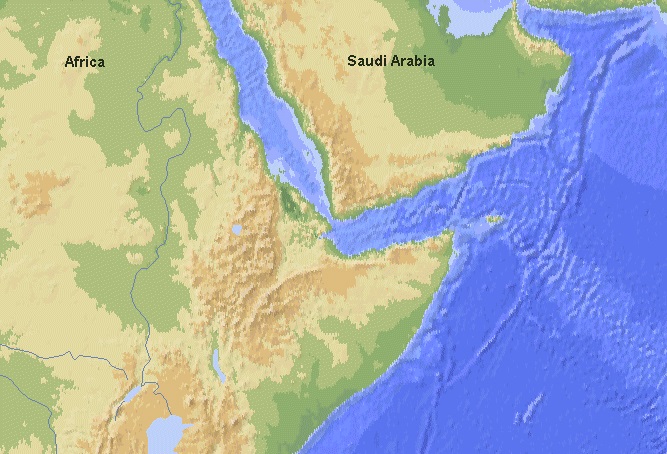
If you will examine the relief map (above), you can see where there was a geologically recent rent of Saudi Arabia from Africa. This is a fracture in the continental crust and is different from deep ocean divergence zones. If you will look closely, you can see where a mountain range was sheared and dragged apart.
The Afar fracture is a three-way split, which some geologists believe is caused by an upwelling magma plume, for lack of a better engine. The area on the African continent running south-west from that fracture locus is the Great African Rift Valley which runs down into the middle of the African continent. The area going north runs along the bottom of the Red Sea, up into the Dead Sea Rift area of Israel, up the Jordon river valley, and continues northward. This Peleg event is most likely a local reference to a widening of that Rift somewhere near or north of Israel.
The next image is a view of the Afar Triangle's tectonic features. In all likelihood, this Rift system was already active before Noah's flood, but Noah's flood triggered renewed activity. I state that because the path of the Rift from Israel continues to run south for the entire length of Ethiopia. It seems to match the described path of the river Gihon, one of four that flowed from the Garden of Eden.
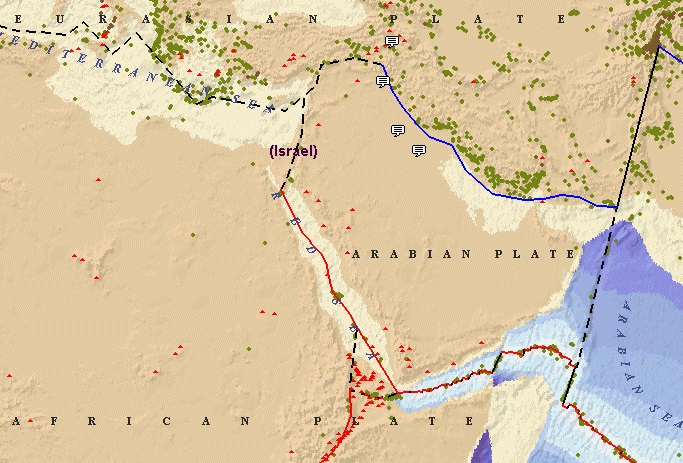
"And the name of the second river is Gihon: the same is it that compasseth the whole land of Ethiopia."
(Genesis 2:13 KJV)
If that is true, then there has been considerable tectonic activity since the Garden of Eden, and Noah's flood may have been just a contributing driver of latter changes.
Now, as for how man and animals got to places like Australia and the Americas, it is possible that they migrated there on dry land during the 101-year interval between the flood and the subsequent plate settling. Possibly, sea levels may have risen quite a bit since the post-flood migrations began, and even more after the Days of Peleg. An examination of the geology of the region between Indochina and Australia shows that the sea between the two continental masses is relatively shallow.
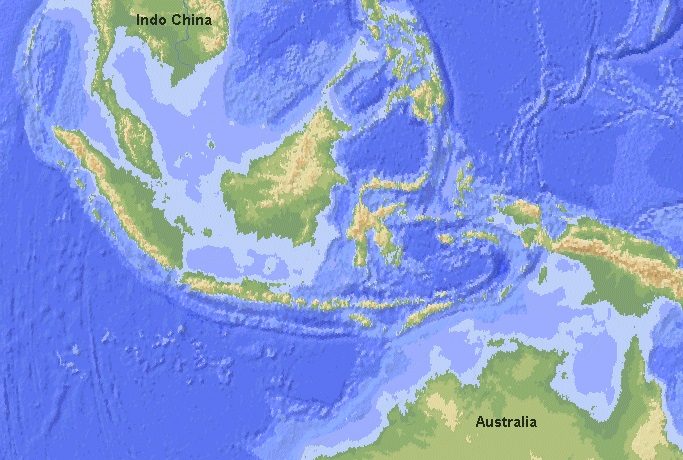
The same is true of the Bearing Straits separating Alaska from Russia, where the waters are only about 50 feet deep between the tip of Asia and North America. It is theoretically possible that in the 101 years following the flood, and before the events of Peleg's days, narrow land bridges (which today are submerged) may have still existed between many places across the globe. The fact that the ruins of many ancient cities in the Mediterranean Sea area, which postdate the time of Noah's flood and are found underwater today, tells us that global sea levels have increased by several meters since those cities were built, or there has been wide-spread subsidence since then. Regardless, an appeal to present-day sea levels is not a valid argument against post-flood migrations to regions now inaccessible across dry land.
Assuming that some land bridges existed briefly after the flood by whatever mechanism, the question is: Did man and beast have sufficient time to migrate from the resting place of the Ark to other continents before the dividing? Well, let's do the math:
If you calculate the distance from eastern Mesopotamia to the tip of Australia and divide it by 100 years, you will find that both man and beast would only have to migrate less than 80 miles a year (0.21 miles a day) in order to reach Australia; less than 55 miles a year (0.15 miles a day) to reach North America via the Bearing Straits; and less than 48 miles a year (0.13 miles a day) if a land bridge (or possibly an ice bridge) existed across the northern polar regions. Those average daily distance requirements are much less than most people walk each day in their normal routines. The data support the Scriptures.
"These [are] the three sons of Noah: and of them was the whole earth overspread."
(Genesis 9:19 KJV)
Shortly after the Ark landed on the mountains of Ararat, the families of mankind spread across the world. At that point in time mankind all spoke a common language and the bulk of them appear to have migrated westward, although it is safe to assume that some settled near the place where the Ark came to rest, and the oral tradition of Gilgamesh and the flood probably originated with the latter. Those people who did migrate westward are spoken of in Genesis 11:1-2:
"And the whole earth was of one language, and of one speech. And it came to pass, as they journeyed from the east, that they found a plain in the land of Shinar; and they dwelt there."
(Genesis 11:1-2 KJV)
That land of Shinar is Babel (Babylon), and there the Bible says the Lord confounded their language and from there they scattered out across the face of the Earth.
Linguistic researchers have put forth the results of studies which tend to indicate that all the Indo-European languages originated in ancient Turkey. Although the given time frame of this occurrence is off by a few thousand years (and is probably conjecture), it is very interesting to see that otherwise it is in close agreement to where the Bible tells us what happened at Babel in the post-flood world.
Other Evidence of Geologically Recent Sea Level Changes
The geology of the Earth's oceans shows evidence of major, and in some cases, rapid fluctuation in sea level across recent geologic history. Such evidence can be found in areas near the continental margins. In the Atlantic Ocean, just off the New England coast, there is an underwater mountain chain that is evidence of this.
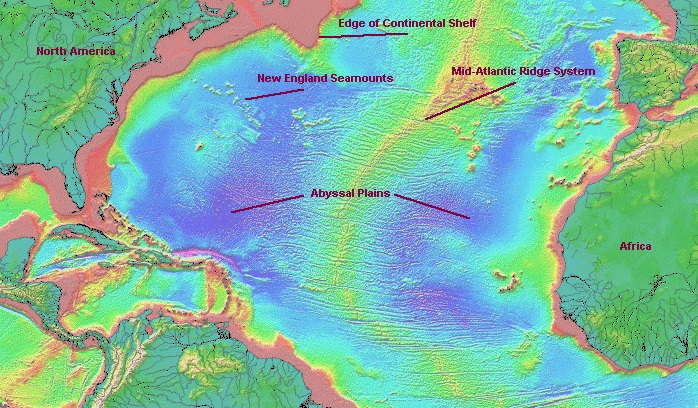
The New England Seamount chain stretches about 1,600 miles southeast of New England. This chain has more than 30 major peaks, all a kilometer (3,281 feet) or more below the surface. There is evidence to confirm that the tops of these seamounts were once at or above the surface of the ocean in the relatively recent past. Deep-sea dredging of some of these seamounts brought up Eocene (37-58 mya) limestone, which is of shallow water origin. In a subsequent visit to the seamount in the research submarine Alvin, there was the first eyewitness observation reported of dead coral. (Coral only grows near the surface.) Rock samples were also collected which contained bits of dead algae (which only grows within 100 meters of the surface). The conclusion is that these seamounts have either subsided on the order of one kilometer since the Eocene, or that sea level has changed drastically since the Eocene.
Research references: J.R. Heirtzler, et al, "A Visit to the New England Seamounts" American Scientist 65 (1977). Wolfgang Schlager "The Paradox of Drowned Reefs and Carbonate Platforms" Bulletin of the Geological Society of America 92 (1981). Harold L. Levin "Contemporary Physical Geology", Crustal Deformation and Global Tectonics, page 290, figures 9-38 & 9-39, (1981)
This conclusion, however, presents a logical problem to mainline science, as coral reefs grow at known rates that would easily stay ahead of geological subsidence of the seamount. They would stay ahead of sea floor spreading by continental drift, and they would stay ahead of gradual elevations in sea level, as assumed under Uniformitarism Earth Science paradigms. The New England Seamounts are not unique. Similar recorded occurrences of finding shallow water sediments, reefs, and carbonate platforms in deep water regions have been recorded in many other places in the Earth's oceans, so the New England Seamounts are not an isolated anomaly. Since gradual processes are inadequate to explain the New England Seamount observations, or observations elsewhere, the alternative conclusion is that either the sea floor sank catastrophically, or that extraordinary volumes of water were added catastrophically, or both.
A combination of sea floor downward warping AND increased sea level resulting in deeper ocean basins following Noah's flood would appear a plausible explanation for finding shallow water sediments in deep water regions today. Is there other undersea evidence to support this theory? Yes! It should be noted that the tops of the submerged New England Seamounts are at the same approximate depth as the edge of the Continental shelf, which is also at a depth of about 1000 meters worldwide.
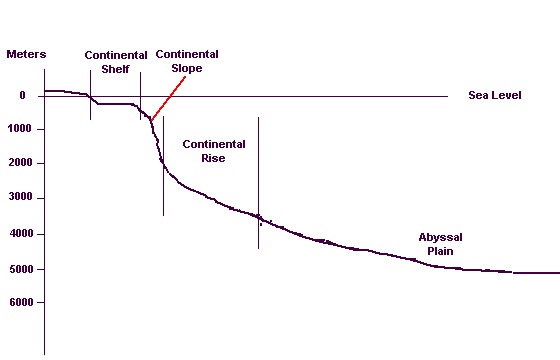
This edge is called the Continental Slope, a zone where the sea floor plunges sharply downward to the Continental Rise and the even deeper abyssal plains. This slope's contour, worldwide, delineates the actual edges of the continents.
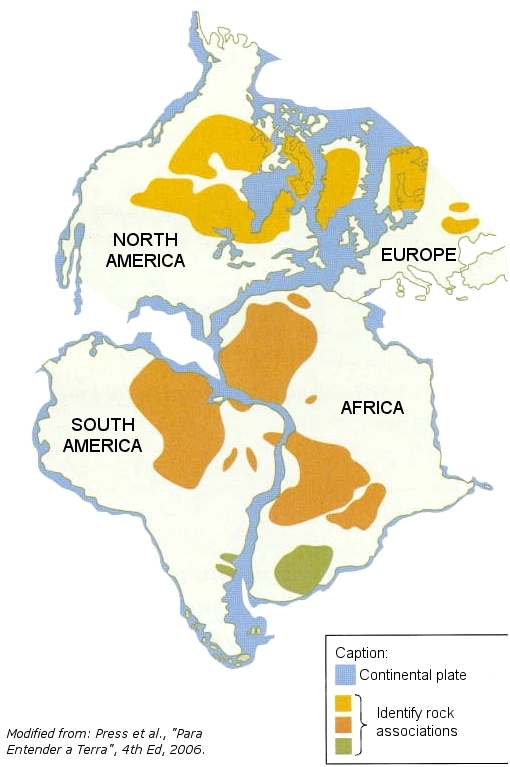
All of the world's continents have their closest "fit" at the present 1000-meter sea level depth if you put then back together like a giant jigsaw puzzle. Although the thicker and relatively lighter granitic continents have drifted apart over time, they essentially have retained the same general shape in respect to their contact with the thinner and heavier basaltic oceanic basins.
Along the outer edges of the relatively flat Continental Shelf, near the Continental Slope zone, are numerous underwater "canyons" which cut downward sharply into the floor of the shelf. These canyons are similar to ones cut by fast-flowing waters eroding away rock as observed on land when the flow gradient is very steep. For example, in a portion of a river that drops 800 feet in five miles, the water speed and erosion power is much greater than a portion of river that only drops eight feet in five miles.
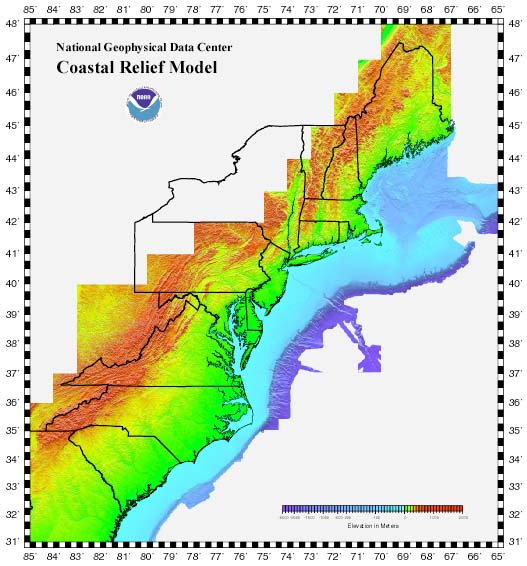
Over 80% of the canyons on the edge of the Continental Shelf can be directly traced back across the relatively flat plain of the Continental Shelf, following now submerged river beds to the mouths of rivers that exist today. This reveals that most of the underwater canyons are clearly extensions of those same present-day rivers, and those canyons were likely cut when the continents stood higher above sea level. In the NOAA graphic above you can see these canyons on the edge of dark blue area.
If the Earth's ocean level was 1000 meters lower before Noah's flood, the canyons are easily explained by the force of the river waters running off the flat land of the present Continental Shelf (which would have been above sea level at that time) and down the relatively steep edges of the continental slope. The rivers would have eroded deep channels in the rock, at the edge of the shelf, as they plunged sharply downward to the antediluvian sea level. High-velocity turbidity currents carrying silt and rock particles could further erode the canyons in post-flood times after they were submerged below today's prevailing sea level.
The existence of the submerged river beds across the shelf indicate that at some time in the past, the Continental Shelf was above sea level, and rivers flowed gently across those coastal plains until they reached the edge area. Near the edge zone the gently flowing rivers turned into cascading rapids and falls, the accelerated flow and sediment load further eroding the deep canyons.
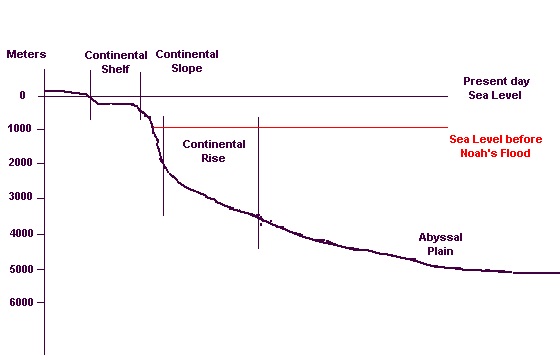
Combining the drowned reefs of the New England Seamounts and the submerged river beds of the Continental Shelf, we have observable physical evidence that supports the flood model. The data suggest both that the floors of the great ocean basins sank to greater depths and that sea level is about 1000 meters higher today than it was before the flood.
In the next chapter we will discuss why the Earth's sedimentary deposits were made well before Noah's flood and are not, as Young Earth Creationists claim, proof of Noah's flood.
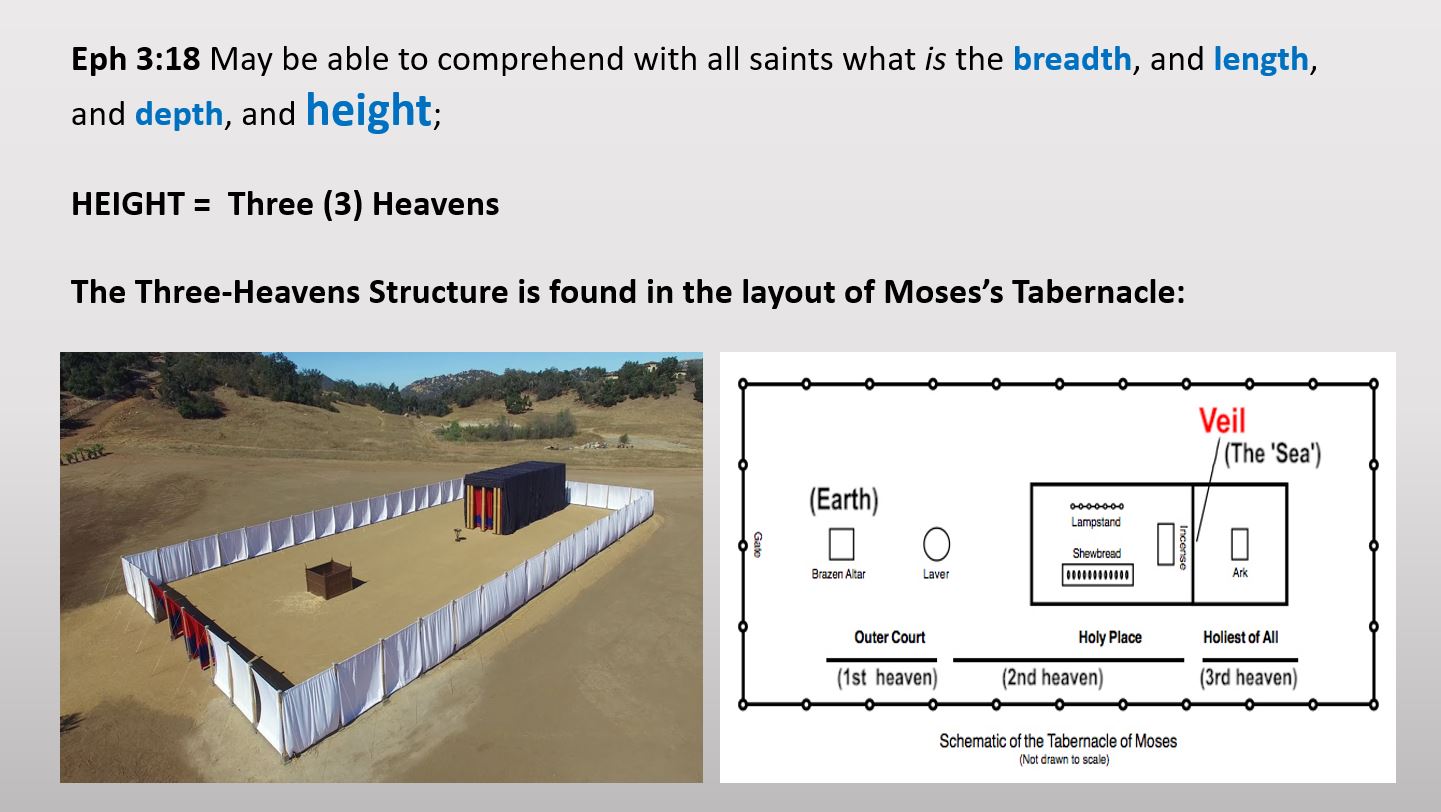

No comments:
Post a Comment